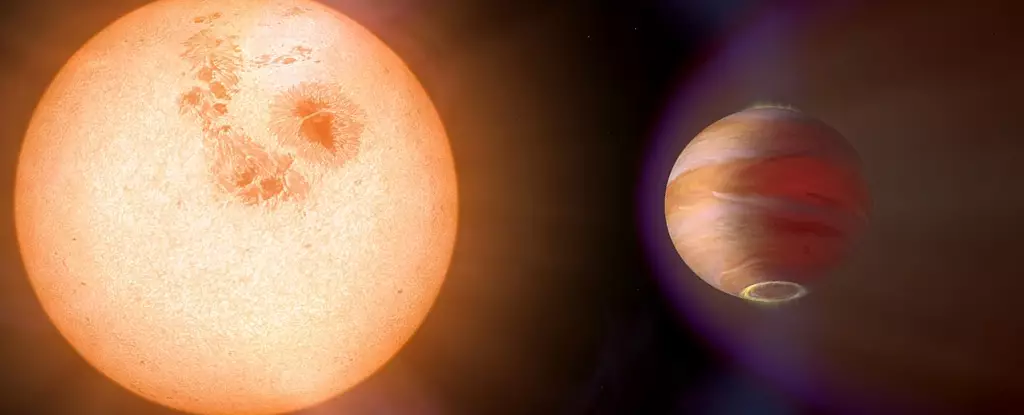In the rapidly evolving field of astrophysics, the ability to precisely measure the metallic content of stars has transformed our understanding of stellar formation and evolution. Advancements in observational techniques now enable astronomers to explore subtle differences in metallicity—an indicator of a star’s chemical composition—among co-natal stars. These stars, which originate from the same giant molecular cloud (GMC), are expected to share similar metallic properties. Yet, recent studies highlight a perplexing phenomenon where significant differences in metallicity occur among sibling stars, raising intriguing questions about the processes influencing stellar chemistry.
Recent research by Christopher E. O’Connor from Northwestern University and Dong Lai from Cornell University presents a compelling argument that these metallicity discrepancies may stem from the destruction of rocky exoplanets, particularly ultra-short-period (USP) planets. These distinct classes of exoplanets orbit their stars at dizzying speeds, completing a full orbit in mere hours. Their close proximity to their host stars creates unique challenges, including tidal heating that can lead to their engulfment by their central stars. This theory posits that co-natal stars, while originating from the same molecular cloud, can evolve in distinct metallic environments based on the rocky planets they may consume.
The Enigmatic Characteristics of Ultra-Short-Period Planets
USPs, while rare—found around only approximately 0.5 percent of Sun-like stars—are thought to possess Earth-like compositions, raising the stakes in our understanding of planetary formation and evolution. The researchers suggest that these planets could have formed in the cooler outer regions of a protoplanetary disk before migrating inward due to gravitational interactions or could represent the remnants of larger planets that lost significant portions of their mass and atmosphere.
Notably, the model proposed by O’Connor and Lai infers that the metallicity “pollution” observed in certain stars correlates with their rocky planet consumption stories. This theory echoes processes observed in white dwarfs, where stellar remnants display altered chemical compositions due to metal accumulation from surrounding debris.
The research further delineates potential mechanisms by which USPs might meet a catastrophic fate within their stars. The authors describe three primary scenarios that could lead to the engulfment of these planets:
1. **High-Eccentricity Migration**: Here, a planet with a highly eccentric orbit risks spiraling into the star as its orbit circularizes due to tidal interactions.
2. **Obliquity-Driven Migration**: This scenario involves gravitational interactions with other celestial bodies, leading to complex orbital resonances that result in rapid inward migration of the USP.
3. **Planet-Planet Scattering**: Violent gravitational interactions among multiple planets can eject rocky bodies into stellar collisions.
With estimates suggesting that between 3 to 30 percent of co-natal Sun-like stars may have undergone such engulfment events, the implications for our understanding of stellar compositions are profound.
However, while O’Connor and Lai present a statistically robust model predicting the dynamics of rocky planet engulfment, they also caution about the limitations of available data. Historical signatures of metallicity pollution can diminish over time as metals settle or become homogenized within the star’s composition. This potential fade complicates our assessment of the prevalence of metallicity differences amongst co-natal stars.
Additionally, the authors raise the potential influence of more violent stellar interactions. Though they posit that such occurrences are relatively infrequent (only about 2 percent estimated to have resulted in pollution), the role of high-eccentricity migration and other evolutionary pathways in stellar dynamics remains a critical area for further exploration.
The study also entertains the role that Hot Jupiters—massive gas giants that orbit closely to their stars—might play in metallicity discrepancies. While they have been observed in similar numbers to USPs, their contribution to the stellar pollution narrative appears less straightforward. Differences in the chemical signatures produced by Hot Jupiters compared to rocky planets could lead to significantly different outcomes in the host stars’ metallicities, potentially obscuring our understanding of the processes at play.
Ultimately, the research posits intriguing correlations between the characteristics of polluted stars and the types of planetary systems they harbor. As our analytical capabilities expand, further studies will likely refine the details of these relationships, revealing the complex narratives that govern stellar evolution. The findings by O’Connor and Lai not only deepen our appreciation for the intricate relationship between stars and their planetary companions but also underscore the importance of a nuanced approach to interpreting our cosmic surroundings, illuminating a still-unfolding story in the fabric of our universe.

